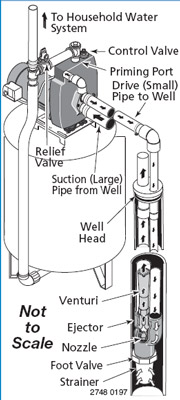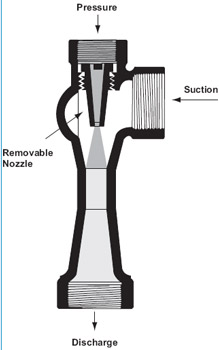Pumps & Systems, July 2007
Q. What is a jet pump? I do not see any reference to it in your standards and would like to learn more about it.
A. A jet pump is actually a venturi nozzle or ejector as shown in the lower part of the figure below, which is used in combination with a centrifugal pump as shown in the upper part of the figure. The most common application is removing water from a well.

The ejector is mounted in the water in the well. Pressurized water is supplied to the pressure end of the ejector and is fed through a nozzle in which its pressure is converted to high velocity. As it exits the nozzle, it drags along water from the foot valve and the combined flow is reduced in velocity in the venturi diffuser, resulting in an increase in pressure.
The discharge from the ejector flows through a pipe to the top of the well and enters the suction of a centrifugal pump. The pump increases the pressure further to satisfy the needs of the system. At that point the flow is divided so that one third to three quarters is returned by pipe to the ejector in the well, and the remainder is supplied to the system.
The advantage to this arrangement is that it can pump water from below the atmospheric limit of a normal pump suction lift, which is about 30-ft. In addition, the ejector can fit in a smaller size well than a deepwell pump, and there are no moving parts in the ejector to become worn.

Q. Rotary pumps are relatively simple and usually inexpensive. Where are they most frequently used, and why are they not more commonly used?
A. Rotary pumps excel in applications with viscous liquids. There is no practical upper limit of the viscosity that can be pumped.
Most such pumps operate with gears, screws, vanes, lobes or other similar devices that run in close contact with a stationary body, and rely on the liquid viscosity to lubricate the space between them and the bearings as well. Some liquid leaks back to the pump inlet, but as viscosity increases, leakage is reduced and volumetric efficiency is increased. Mechanical friction increases with viscosity, so overall efficiency peaks at an optimum viscosity.
Due to the close clearance construction, rotary pumps can handle gases as well as liquids. Consequently, they are self-priming and, unlike centrifugal pumps, will not become air bound. However, they should not be run dry.
The downside is that rotary pumps do not operate well with low viscosity liquids, such as water. The lower viscosity results in increased wear and higher leakage through the pump. In short order, pump performance becomes unacceptable, and the pump is repaired or replaced, probably with a centrifugal. The mechanical sound of meshing gears or other rotor parts can also cause noise, which may be unacceptable.
Pump FAQs is produced by the Hydraulic Institute as a service to pump users, contractors, distributors, reps and OEMs as a means of ensuring a healthy dialogue on subjects of common technical concern. HI standards are adopted in the public interest and are designed to help eliminate misunderstandings between the manufacturer, the purchaser and/or the user and to assist the purchaser in selecting and obtaining the proper product for a particular need.
As an ANSI approved standards developing organization, the Hydraulic Institute process of developing new standards or updating current standards requires balanced input from all members of the pump community. We invite your questions and will endeavor to provide answers based on existing HI standards and technical guidelines.
For more information about HI, our publications, Pump LCC Guide, Energy Saving Video-based education program and standards please visit www.pumps.org. Also visit our new e-learning portal with a comprehensive course on "Centrifugal Pumps: Fundamentals, Design and Applications," which can be found at www.pumplearning.org.

